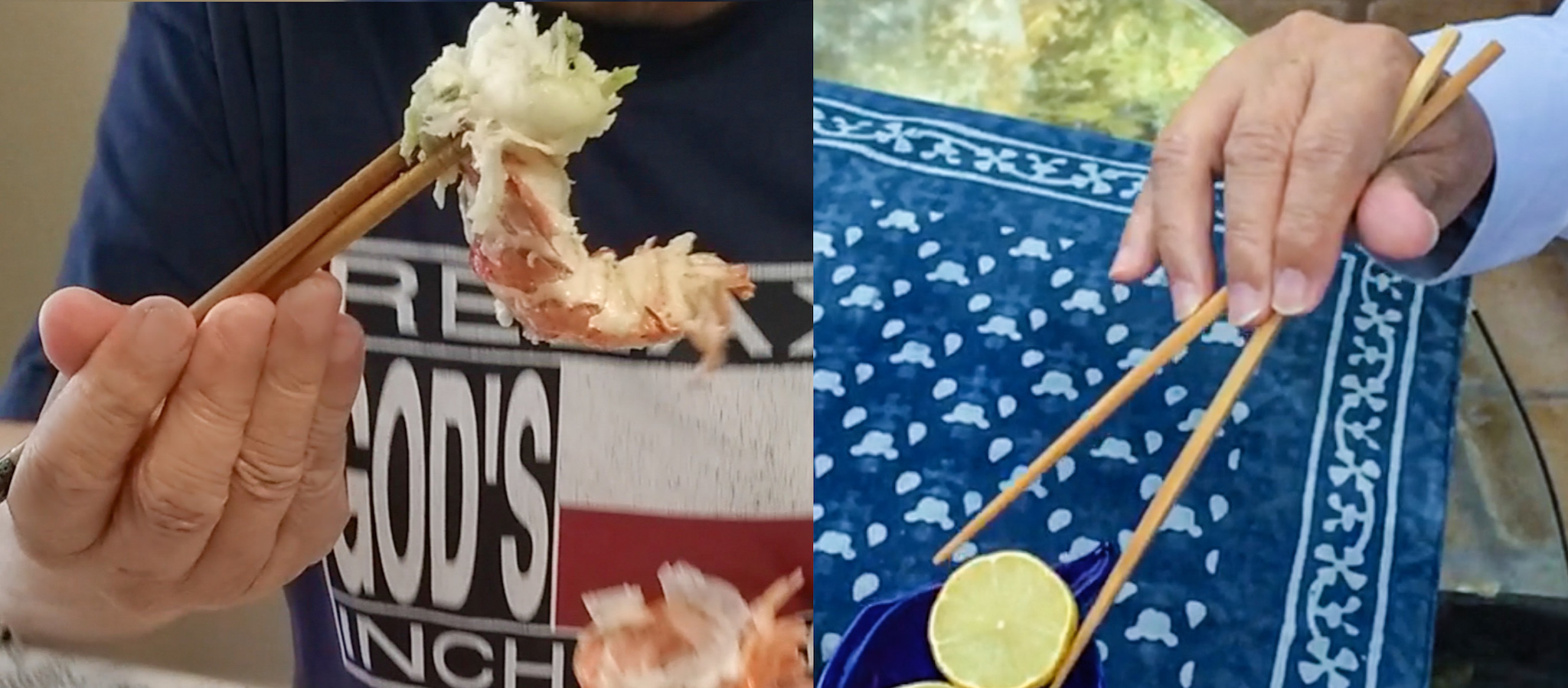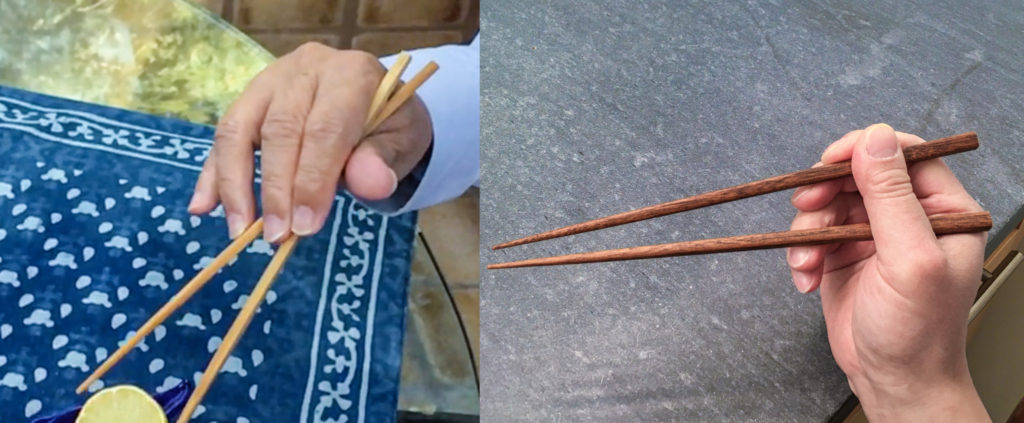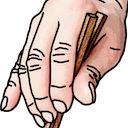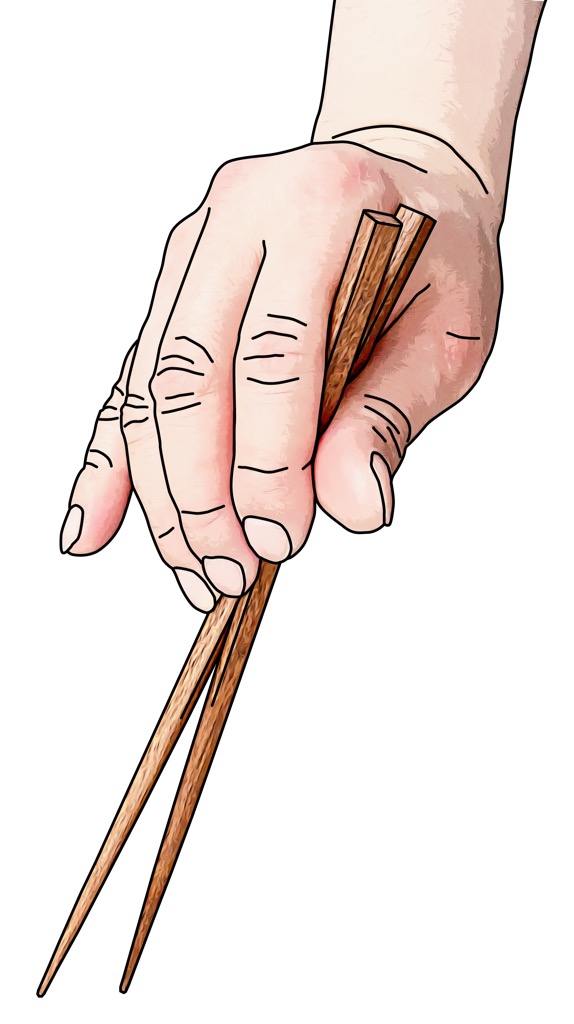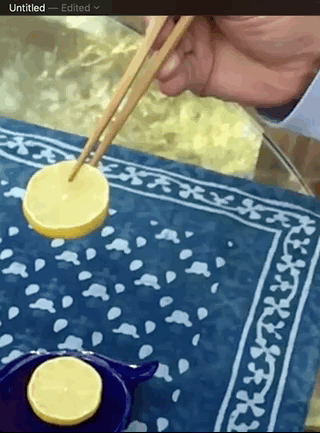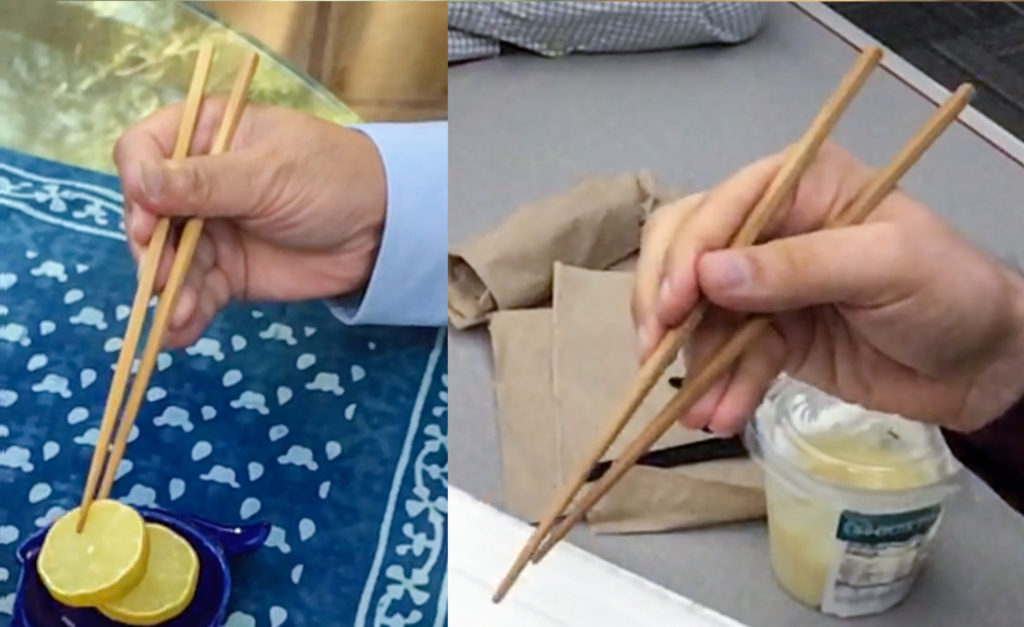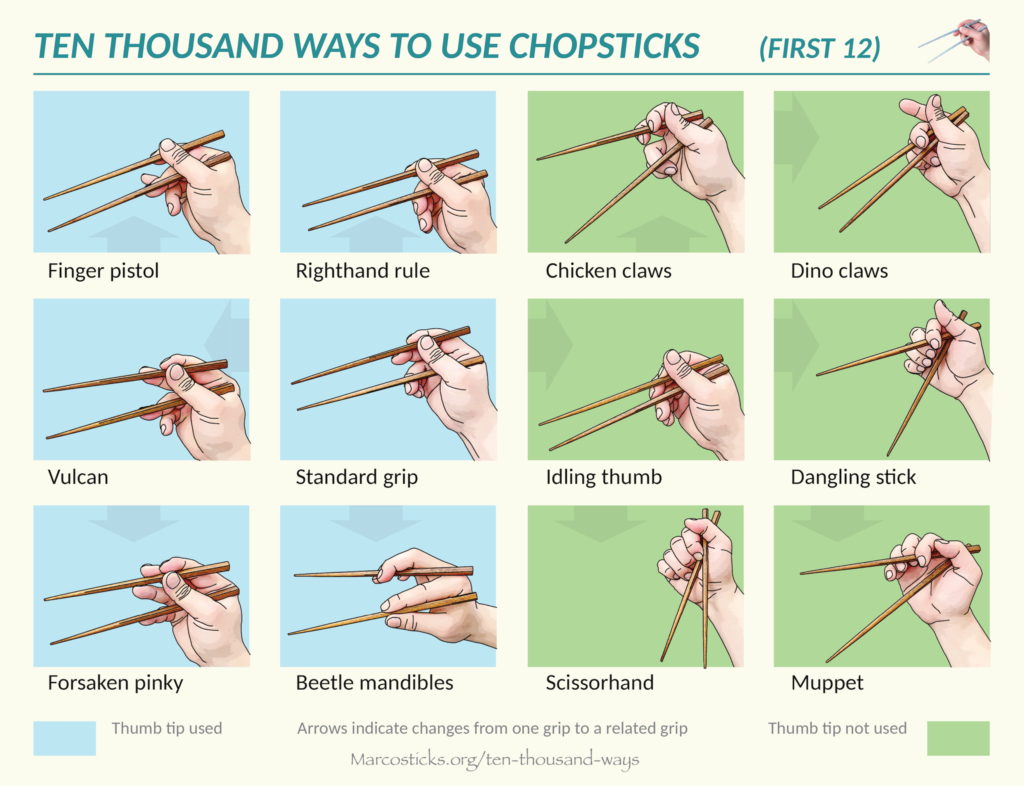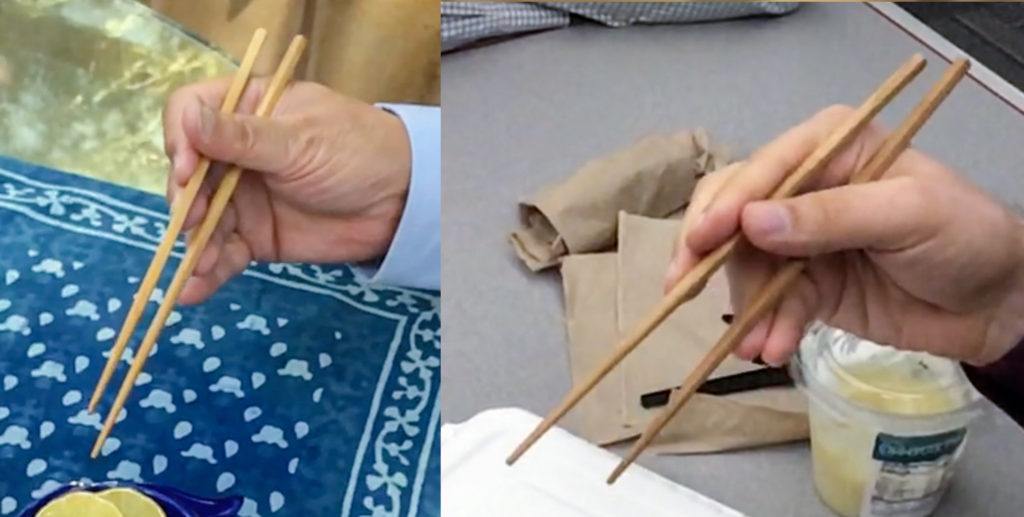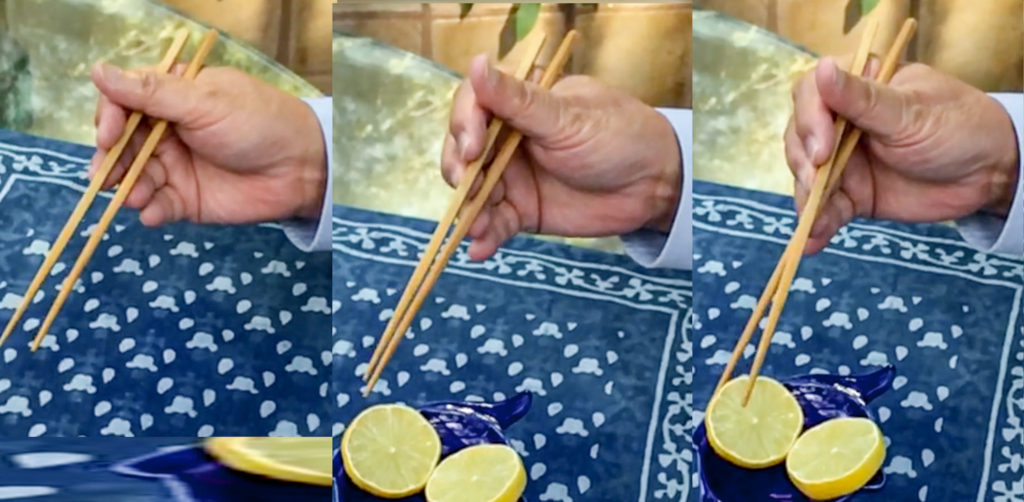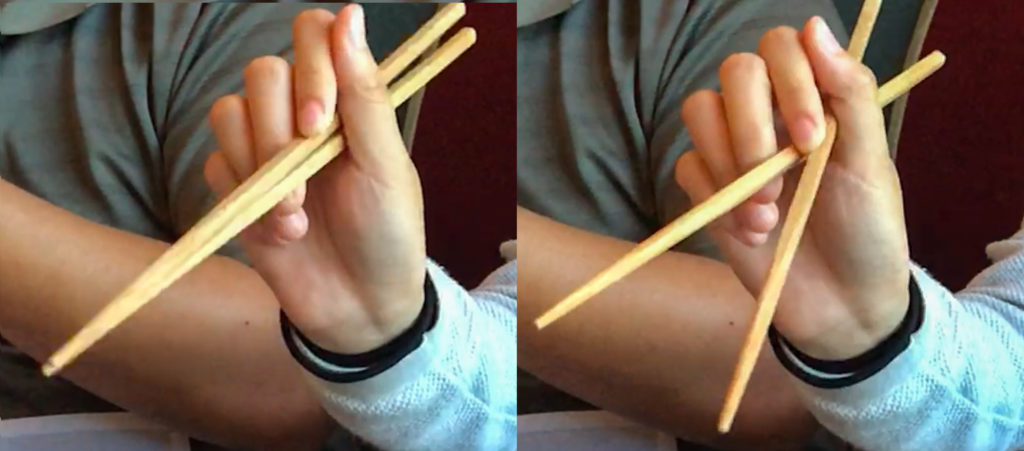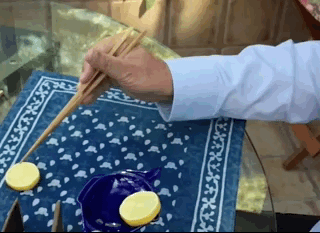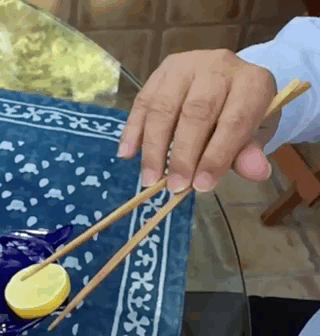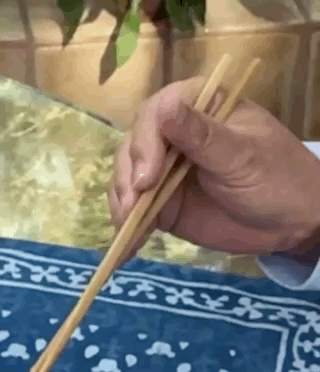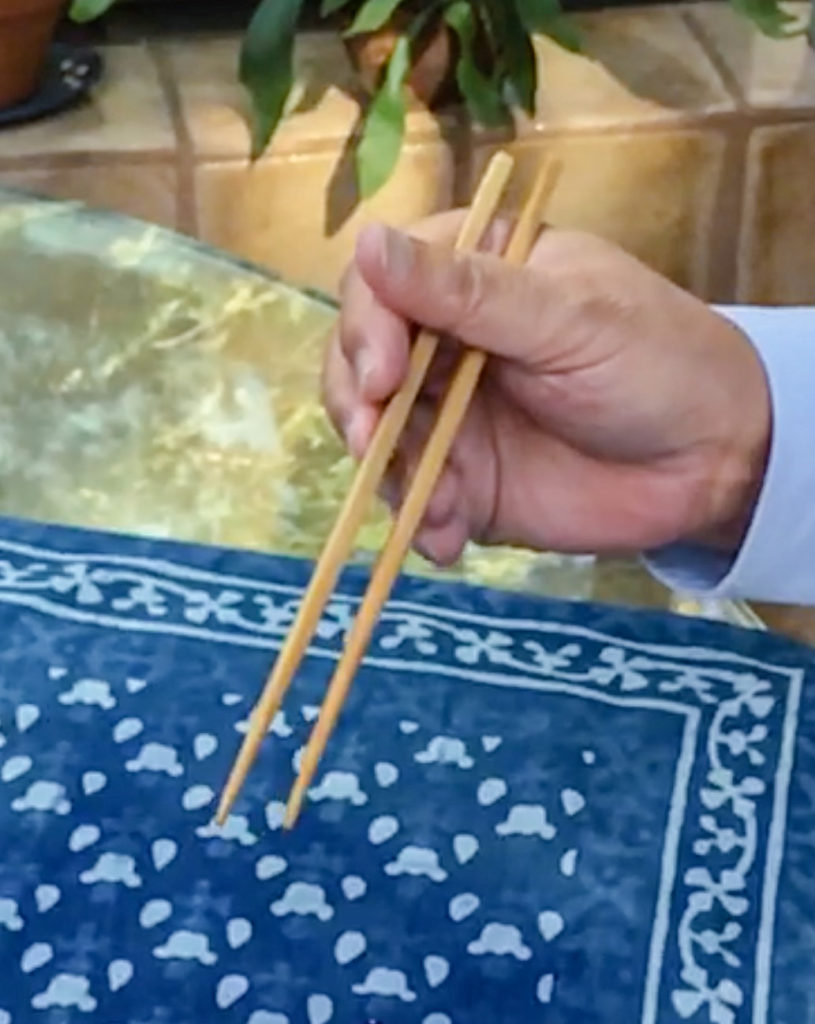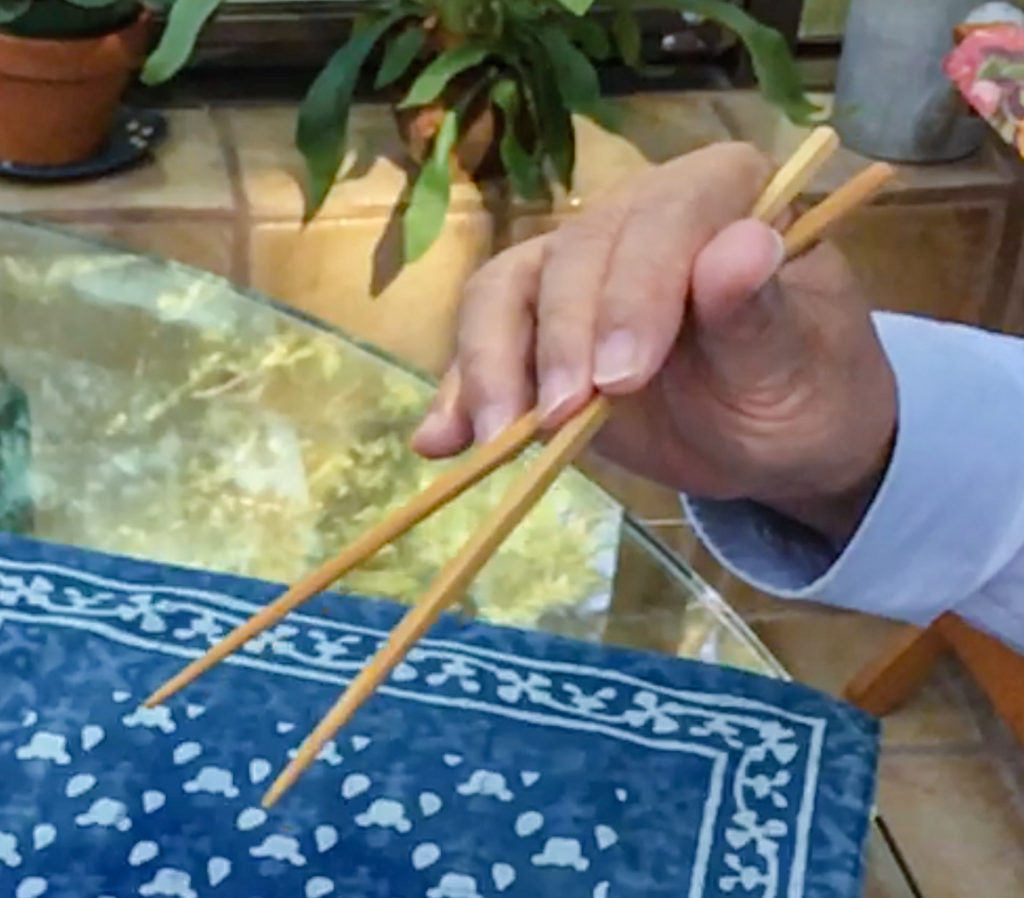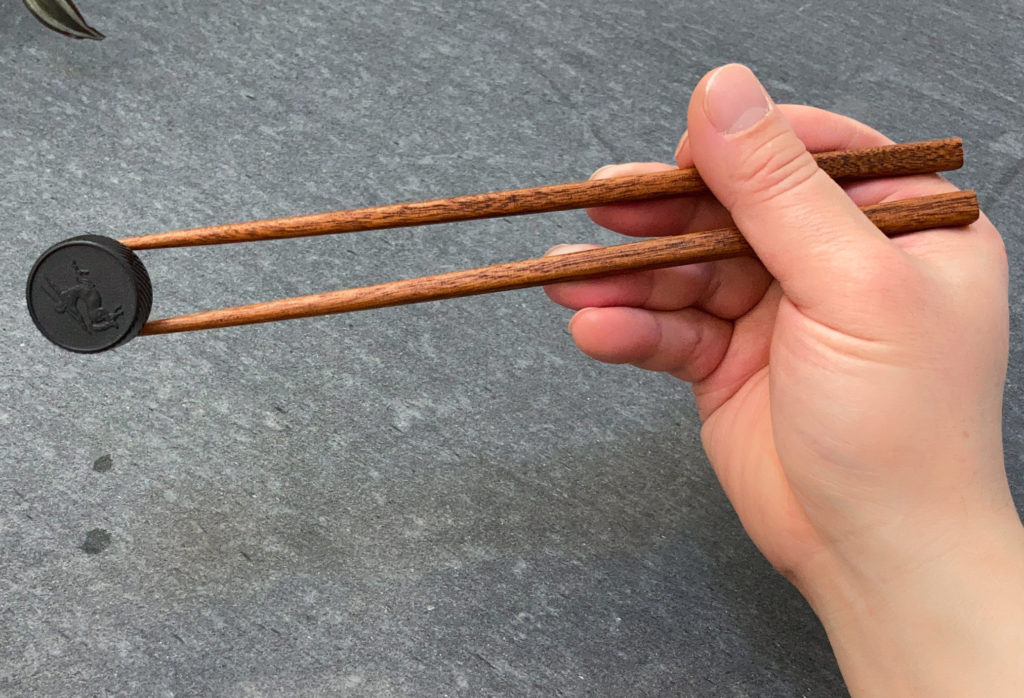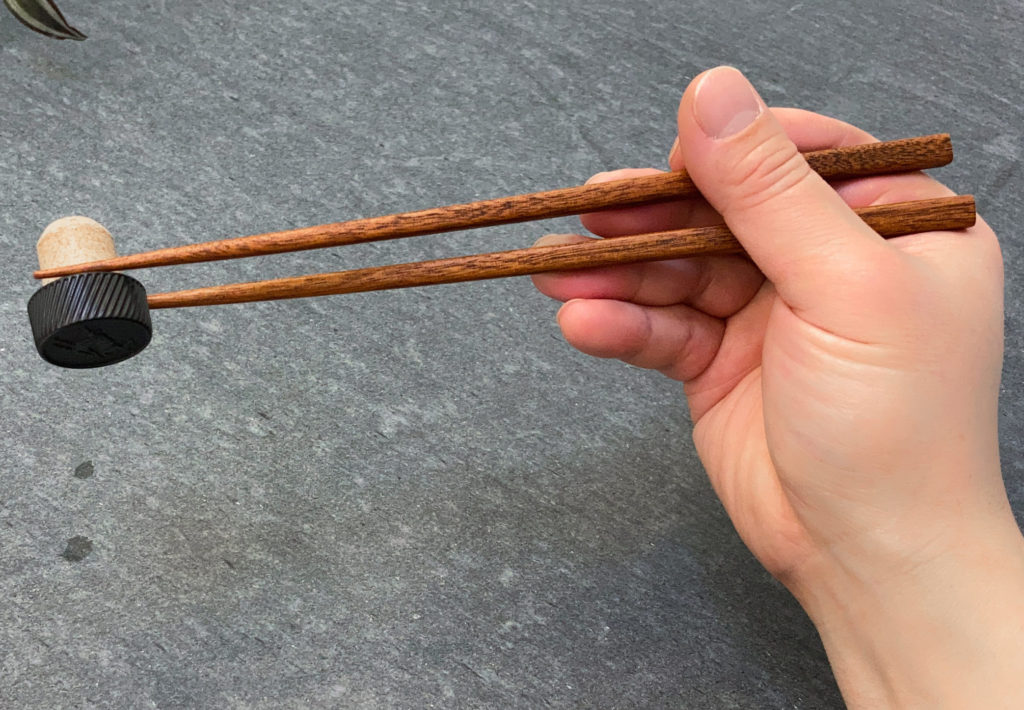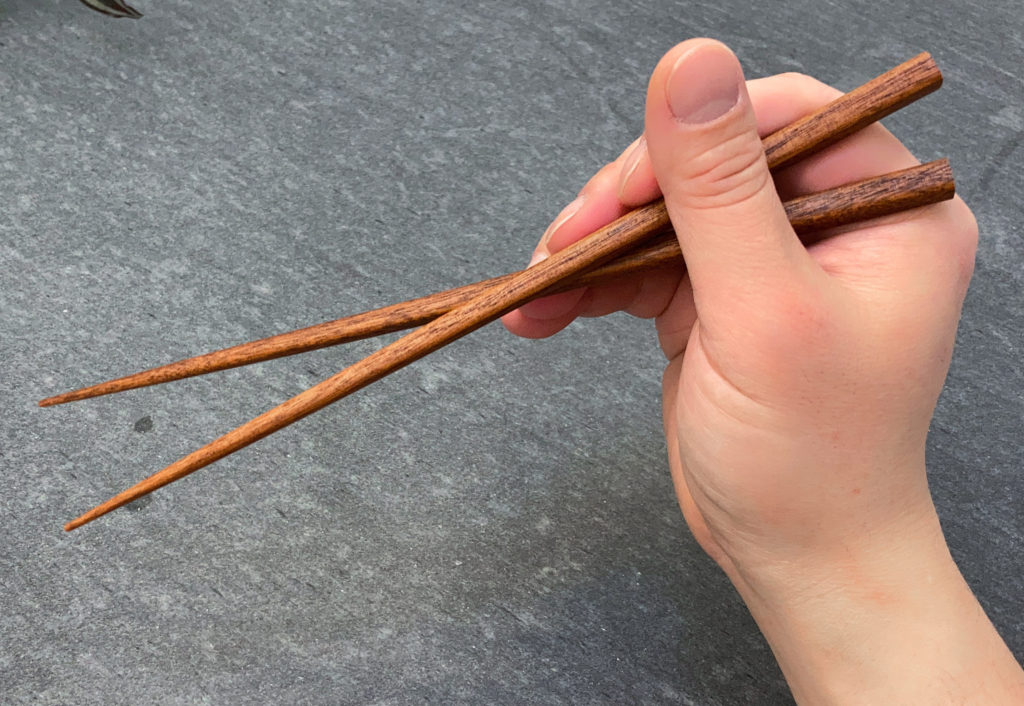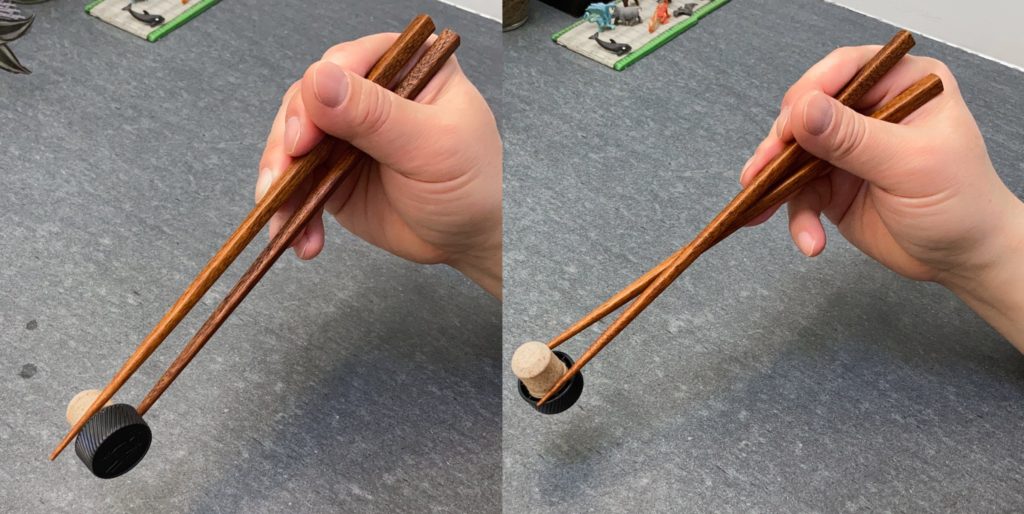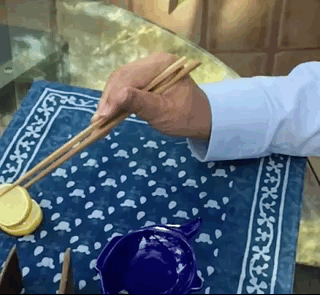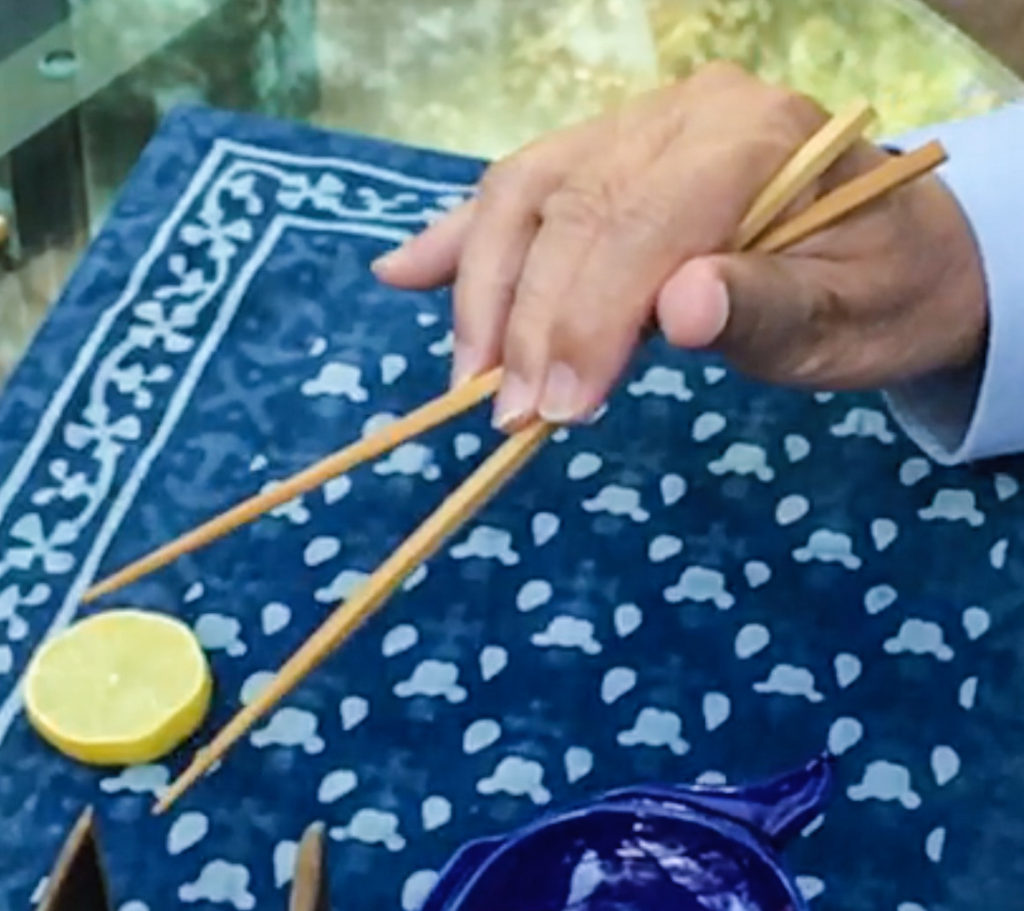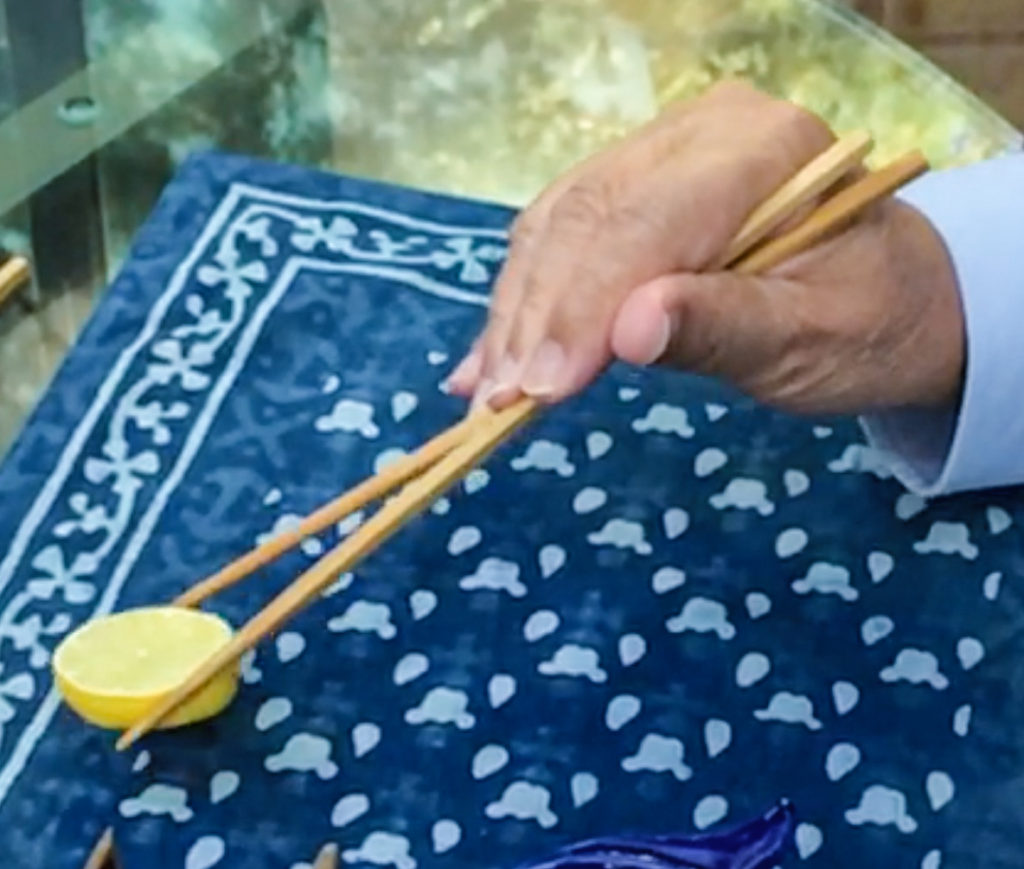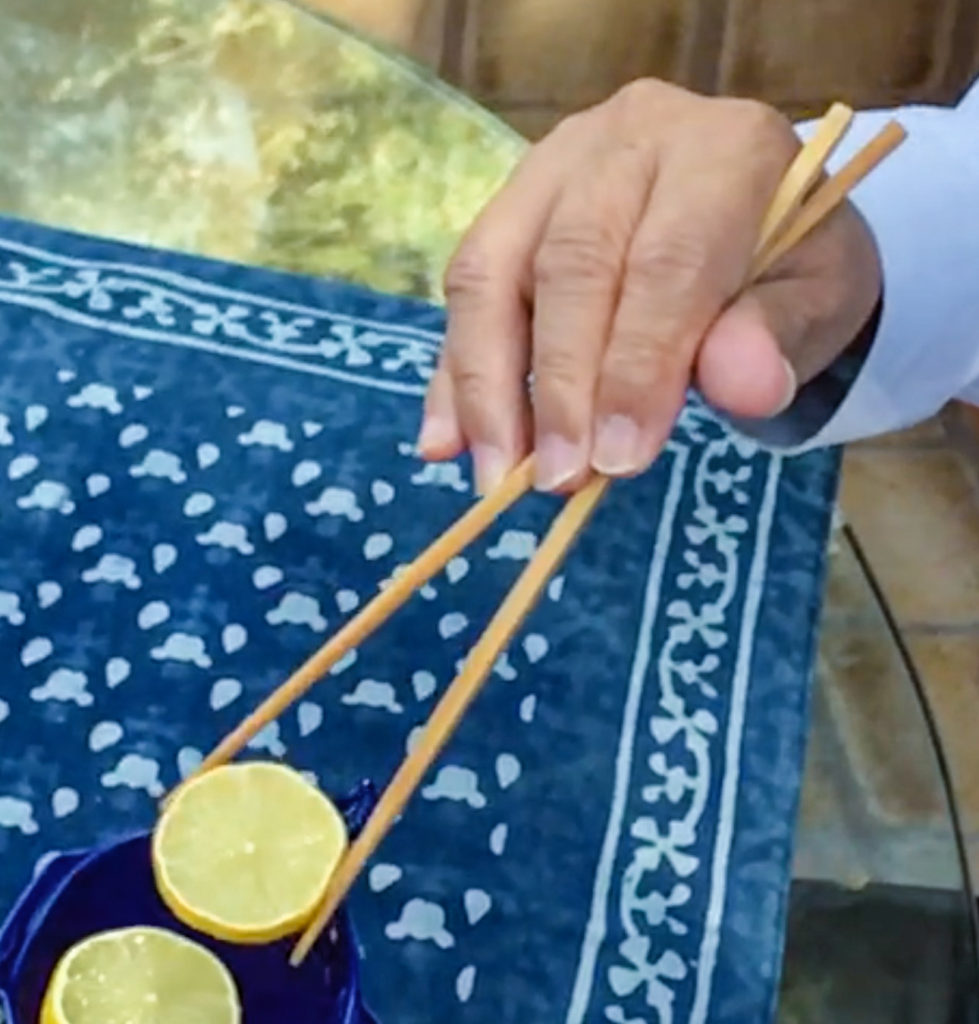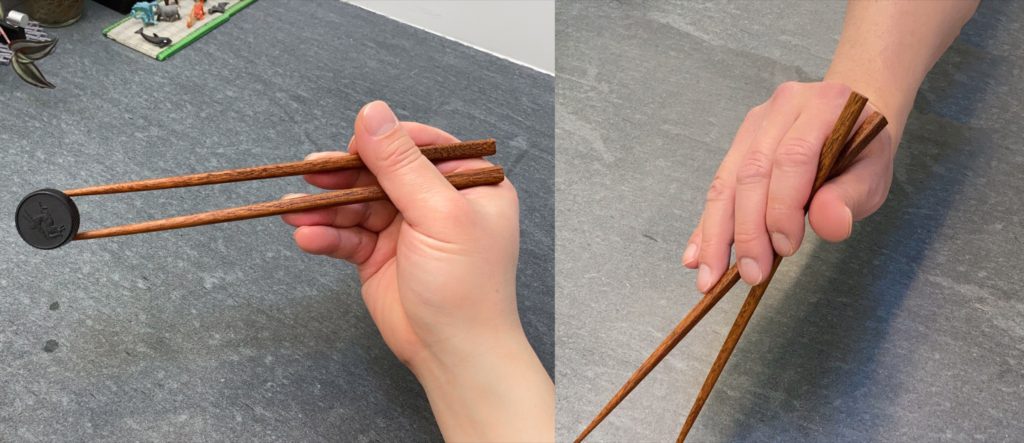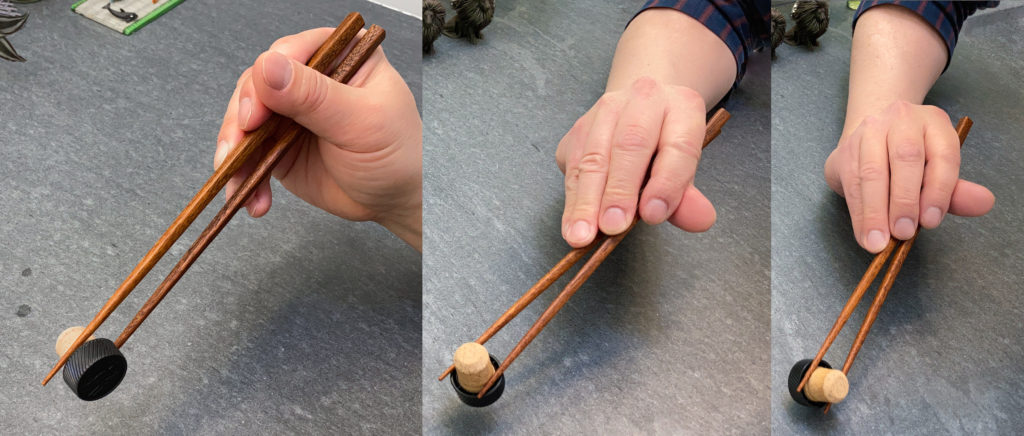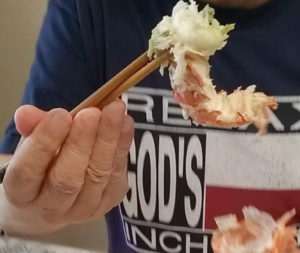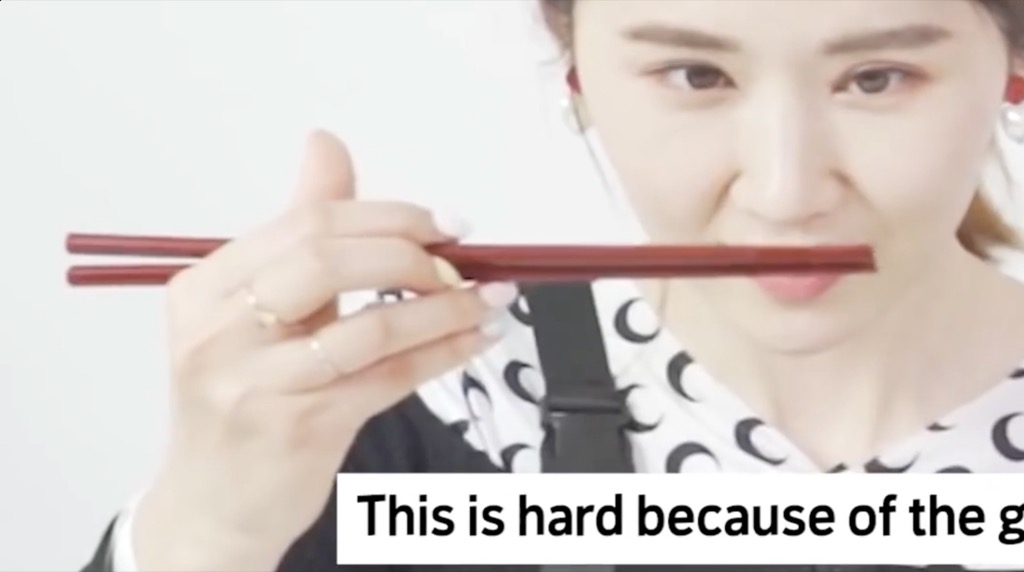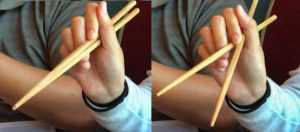Last Updated on 2021 年 06 月 30 日 by 編輯
Cupped Vulcan is an under-swing chopstick grip that resembles a cupped hand. It is the most intricate grip we have examined so far. While we recorded Cupped Vulcan on day one of marcosticks.org, we had not been able to satisfactorily explain how it worked, and why it worked. It was so alien from the traditional Standard Grip.
We had to wait until after we analyzed and published 18 alternative grips, to tackle this complex grip with multi-faceted finger dynamics. Only after we built enough knowledge about different grips, understood how they worked, and mapped out how they related to one another, were we able to unlock the mystery of this Cupped Vulcan grip.
For best results, readers are advised to reference past articles, as they provide concepts and names used in this one. They are: Vulcan, Idling Thumb, Dangling Stick, Scissorhand, Learn to Use Chopsticks, Using vs not using the Thumb, and lastly, Out with the Crossed Type, in with the Under Swing.
內容目錄
Name
The “cupped” part of Cupped Vulcan is self-evident. But it is not the only grip that resembles a cupped human hand. There are more grips that share the same overall appearance, such as the Italian Grip. More cupped grips will be analyzed and published in time.
Every cupped grip also borrows finger placement and finger dynamics from other non-cupped-hand grips. We named the present grip “Cupped Vulcan”, after its adoption of middle finger and ring finger placement, from the Vulcan grip.
Following is the stereotypical compression posture of Cupped Vulcan seen from various angles.
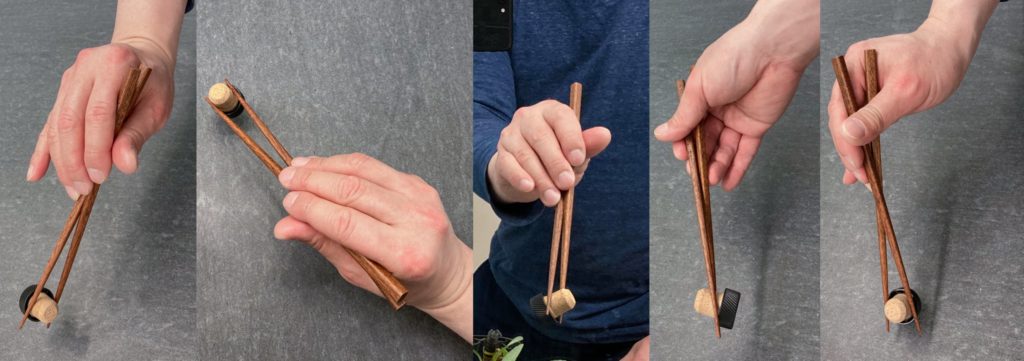
Compared to plain Vulcan
This grip at times looks like the plain Vulcan grip. Examine the following video clip. Ask yourself, how is this different from the plain Vulcan? After all, the user employs the pulp of both middle finger and ring finger. This user appears to operate the two sticks just like plain Vulcan.
Following pictures compare Cupped Vulcan (left) to plain Vulcan (right), at the closed posture. They indeed look very similar. But note how the pulp of the thumb is not used in Cupped Vulcan – only the base of the thumb is used. In plain Vulcan, the pulp of the thumb helps operate the top chopstick.
As a result of the disuse of the thumb pad, Cupped Vulcan holds the two chopsticks much closer to each other. Cupped Vulcan uses the base of the thumb to hold onto both sticks, unlike plain Vulcan where the base of the thumb holds only the bottom chopstick.
This disuse of the thumb changes drastically how Cupped Vulcan operates. It puts Cupped Vulcan squarely in the green side of the following diagram, where the thumb pad is not used in grips. Finger dynamics of Cupped Vulcan shares more similarities with Idling Thumb, Chicken Claws, Dangling Stick, and Scissorhand, because of this disuse of the thumb pad.
Following pictures compare Cupped Vulcan to plain Vulcan, at the open posture. In the plain Vulcan article, we explained that plain Vulcan has very limited range of movement, when a user attempts to open chopsticks using the Vulcan salutation gesture, with help from the thumb pad. In the article, the range discussed was that of the classic swing, where the top chopstick swings upward. The picture below to the right shows the maximum range of plain Vulcan.
Cupped Vulcan suffers from even more severe handicap, when it comes to swinging the top chopstick upward. The picture above on the left shows the maximum tip separation range in the classic swing sense, for Cupped Vulcan. This limited range is partially due to the fact that no finger can help pry the top stick upward – recall that the thumb pad is not used.
An under-swing variant
The limited classic swing range is inconsequential to Cupped Vulcan users. As we will explain later, users of Cupped Vulcan never attempt to open tips of chopsticks using classic swing, at all. They have other tricks up their their sleeves.
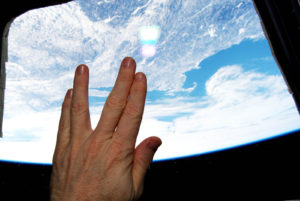
Instead, Cupped Vulcan relies on the under swing movement to operate the top chopstick. With under-swing, the top chopstick moves downward, and to the left. It swings under the bottom chopstick, thus the name.
Following pictures illustrate the same exact pinching of a slice of lemon. The two pictures are taken from two different viewpoints. Use the angle of the slice of lemon to orient your viewpoint. The picture on the right shows that Cupped Vulcan pinches food from left and right, unlike classic swing grips such as plain Vulcan which pinch food from top and from bottom.
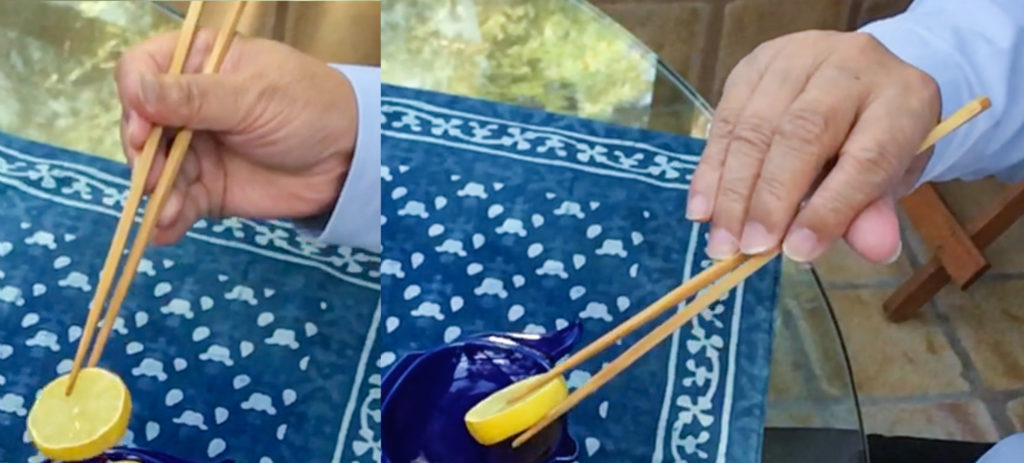
Following pictures illustrate how a user swings the top chopstick down, on the left side of the bottom stick, and then pinches the slice of lemon sideways.

We now break up the above sequence into two actions: 1) reaching the open posture using the under swing movement, and 2) returning to the closed posture using a reverse under swing movement.
Following three pictures illustrate how a user manipulates the top stick to reach the open posture. Pay attention to the middle finger. It is the main actor. The middle finger pushes the top stick to the left to clear the bottom stick. Its accomplice, the index finger, then adds a downward push. The base of the thumb yields accordingly, but still keeps firm pressure on the top stick against the base of the index finger, and against the pulp of the middle finger. Finally, the top stick swings under the bottom stick. We call this state the under-swing open posture.
The under swing movement of the top stick is reminiscent of the Scissorhand. Indeed, they share many similarities. But movements of Cupped Vulcan is more intricate and difficult. In general, Cupped Vulcan does not let the two sticks touch each other. Its scissor-like motion is only an illusion. Cupped Vulcan does not rely on scissor lever actions as Scissorhand does.
Following three pictures illustrate how a user manipulates the top stick, to pinch a small (thin) food item. Similar to Scissorhand, it relies on the base of the thumb to squeeze the top stick back from its open posture. When the slice of lemon is firmly pinched by tips of chopsticks, we call this state the under-swing payload posture.
Unlike most alternative grips, this grip does not have a pure “closed” posture where tips of chopsticks touch each other, without picking up food. More specifically, it does not have a stable closed posture without a piece of food wedged in between chopstick tips. Next section will elaborate on this.
Payload-flipping between under-swing and classic
Cupped Vulcan is a grip with many tricks. Watch the video below. Keep your eye on the slice of lemon. What happens to the slice of lemon, as it is picked up and moved? How did the slice flip 180° during this transit?
This payload-flipping power is unique to Cupped Vulcan. No other alternative grips are configured to do this. Not even grips that closely resemble it, such as Scissorhand and plain Vulcan.
Many factors together enable this grip to flip a small payload. We have already hinted at one such factor earlier. Cupped Vulcan does not allow the two sticks to touch each other during the alternating motion between open and payload postures.
Now we repeat just the lemon-flipping part of the video in slow motion. The slice of lemon is flipped back and forth almost 180° degrees. But the orientation of the hand almost never changes.
Focus on the top chopstick. As the top stick is moved from the under-swing open posture to the under-swing payload posture, something subtle happens. The base of the thumb is involved in this trick. Instead of pinning the top stick sideways against the payload, the base of the thumb nudges the top stick slightly upward, during this movement. Look at the slow motion video below.
The video above shows how this tricks is possible with Cupped Vulcan. As noted earlier, there is a small distance between the two chopsticks. Look at the rear ends of sticks. They are not as spaced out as in Standard Grip. But they are not clutched together as done in Scissorhand either. Rear ends are spaced just right, for this trick to be deployed with regular-sized food items.
Why stick twisting is needed
Imagine that the tip of the bottom stick is fixed in 3D space. Trace the motion of the top stick in this twisting maneuver. You will find that its tip does a planetary rotation around the bottom tip. On the rightmost side you will find the under-swing open posture. On the leftmost side is what we call the classic payload posture.
The same 4 steps are reproduced below, with a bottle cap as payload. The orientation of the bottle cap serves as an indicator, showing the rotation of the top tip around the bottom tip. The stick twisting allows a user to transform an under-swing payload posture (second from right) to a classic payload posture (leftmost).
The need for this transformation is clear. The classic payload posture on the left generates more compression power than the under-swing payload posture on the right.
That this transformation sometimes happen by itself requires some explanation. It can be summarized as: the under-swing payload posture is inherently unstable. When the payload is of the right size, the two (visually) crossed chopsticks will tend to twist on their own, and settle on the more stable classic payload posture. This is because when a payload is picked up, the two chopsticks, the base of the index finger, and the payload itself become a spatial four-bar linkage.
Payload size influences stick movement
As mentioned earlier, this stick twisting is possible because of the separation of the two chopsticks. The gap at the rear end determines the size of payload that can be rotated from the under-swing posture to the classic posture. The right size of payload makes the spatial four-bar linkage work.
The cork from a bottle cap shown earlier is about the ideal size. Anything smaller than the thickness of pasta, or bigger than the height of that bottle cap, will be difficult to flip.
Tiny payloads are almost equivalent to no payload. The two chopsticks find no solid surface to wedge their tips into, for leverage in twisting. In other words, there is no four-bar linkage to be had. There are only 3 bars forming a chain, not a loop. This is why we mentioned earlier that Cupped Vulcan has no stable closed posture that does not involve a payload between tips.
Large payloads similarly disables the four-bar linage mechanism. Large payloads remove the classic payload posture from the menu of available options. Next video shows a user left with only the under-swing movement, when told to pick up lemon slices by grabbing the rind, and not pulp. This user instinctively avoided payload flipping. Instead, he stuck with the simple under-swing movement for extending tips, and for pinching large items.
The four key frames in the video are reproduced below. From the left: under-swing open posture, pinching the lemon slice, moving the slice while holding the under-swing payload posture, and lastly, going back to the under-swing open posture to drop off the slice.
Transitions between postures
Let’s review a slow-motion clip shown earlier. This alternating motion covers most eating use cases in Cupped Vulcan. The user drops off a slice of lemon, at the classic payload posture. He then moves the top stick to the under-swing open posture. He pinches food, turning the hand into the under-swing payload posture. Finally, he twists the top stick, transforming the hand into the classic payload posture. He then drops off the slice. The cycle then repeats.
Following images show the key stages between the under-swing open posture and the classic payload posture. Start on the right, and move leftward.

Earlier we also showed a slow-motion clip highlighting the top stick being twisted. In this clip, the wrist can be seen flipping in the same direction as the top stick is twisted. This wrist flip serves several purposes. One purpose is to re-orient chopsticks, in order to bring the food item to the mouth. In general, stick twisting and wrist flipping occur together in real life eating situations.
The following diagram captures transitions between three postures we have named and analyzed. The main cycle involves one-way transitions through all three postures, as we just discussed. The payload is flipped after it is picked up. The second cycle is used, when picking up large items that cannot be easily flipped.
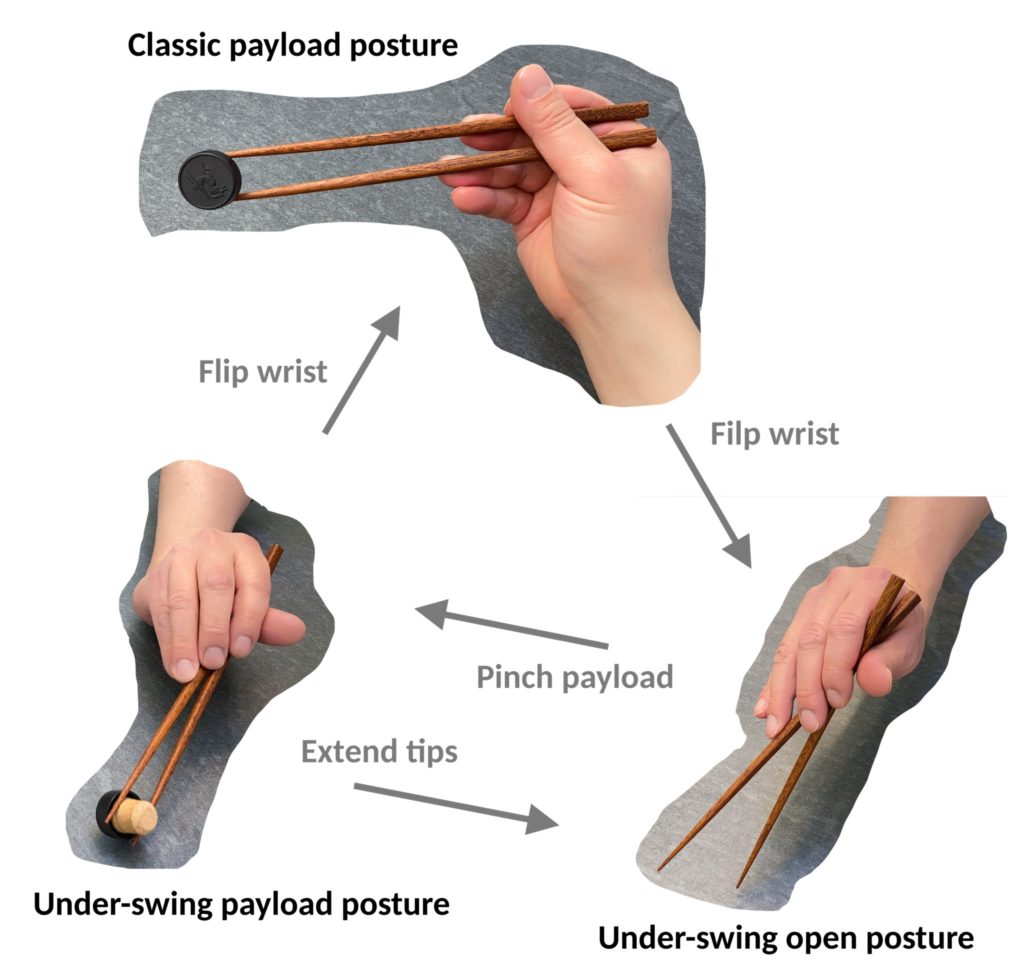
Free gravity assist
The flipping of the wrist serves a second purpose. Look at the two pictures below, showing classic payload posture on the left, and under-swing open posture on the right. Per the transition diagram discussed earlier, there is a transition from the left posture to the right posture. But there isn’t a transition from the right to the left. This is because there are no fingers that can comfortably reverse the under-swing movement, in this particular hand stance. With the palm partially facing upward, gravity pulls everything towards the soapstone tabletop.
In fact, with this wrist stance, even making the usual transition from the left posture to the right posture is tricky. Gravity would pull the top stick down, to touch the bottom stick – an undesirable condition for Cupped Vulcan. And fingers in this grip are not positioned to prevent that. In addition, suppose the under-swing movement overshoots. This grip is ill-equipped to correct the overshoot, in this particular stance.
Consider the picture shown below to the left. In this classic payload posture, with the gravity pulling everything toward the tabletop, the middle finger can easily push the top stick up and away from the tabletop, effectively initiating the first step of the under-swing movement – aka, top stick moves to the left side of the hand. If the wrist turns in other directions instead, gravity would mess with the top stick, pulling it to come in contact with the bottom stick.
Consider the picture shown above to the right. In this under-swing open posture, with the palm facing down, gravity pulls the top stick down straight toward the tabletop. Gravity effectively executes the second stage of the under-swing motion, by bringing the top stick under the bottom stick. To complete the under-swing motion, the base of the thumb merely nudges the top stick to a stop. With this wrist stance, the base of the thumb is oriented to nudge upward, directly against gravity. If the wrist turns in other directions instead, gravity would mess with the top stick, pulling it to come in contact with the bottom stick.
The gravity assist only applies to movements of sticks, when they carry no payload. As mentioned, a regular-size payload enhances this grip. With a payload completing a spatial four-bar linkage, the thumb, the index finger, and the middle finger can easily twist the top stick between the classic payload posture (left), and the under-swing payload posture (right).
With that said, most users will still twist their wrist, in sync with the top stick twist, even when carrying a payload. Doing so leaves chopsticks at the right gravity-assisted configuration, at either ends of the alternating motion, in case gravity assist is required.
Cupped Vulcan clearly leverages gravity, to make up for what fingers in this grip cannot do. But such use of gravity is not unique to this grip. Dangling Stick and Scissorhand, for instance, also make use of gravity assist.
What works well on Earth, however, may not work elsewhere. Specifically, these grips will not work well in space. We suspect that astronauts in the International Space Station would have a hard time wielding these alternative grips, in zero gravity.
Transformation into a virtual fork
Cupped Vulcan has one more trick to offer. This is a special transformation that it shares with under-swing grips such as Scissorhand and Italian Grip. These grips can transform a pair of chopsticks into a virtual fork, for prying loose difficult-to-eat food.
Following sequence of pictures demonstrate such transformation. For this special occasion, the two sticks are allowed to touch each other. In fact, this contact is necessary for the integrity of the virtual fork.

For this special move to work, tips of chopsticks are stuck into stubborn food. Rear ends of sticks are firmly held down by the base of the thumb. The index finger and the middle finger serve as fulcrum for the two sticks. The thumb then twists clockwise, from the point of view of the user. This generates a powerful prying force on both tips.
We call this posture the virtual fork posture. Following pictures compare the virtual fork posture on the left, to the under-swing payload posture in the middle, and to the classic payload posture on the right.
The virtual fork posture breaks the dynamic four-bar linkage. It effectively fixes the chopsticks at the crossing point. Instead of a moving four-bar linkage, we end up with two immobile triangles. This is why the virtual fork is stable, and can generate powerful twisting forces.
We must now update our posture transition diagram to include this new posture.
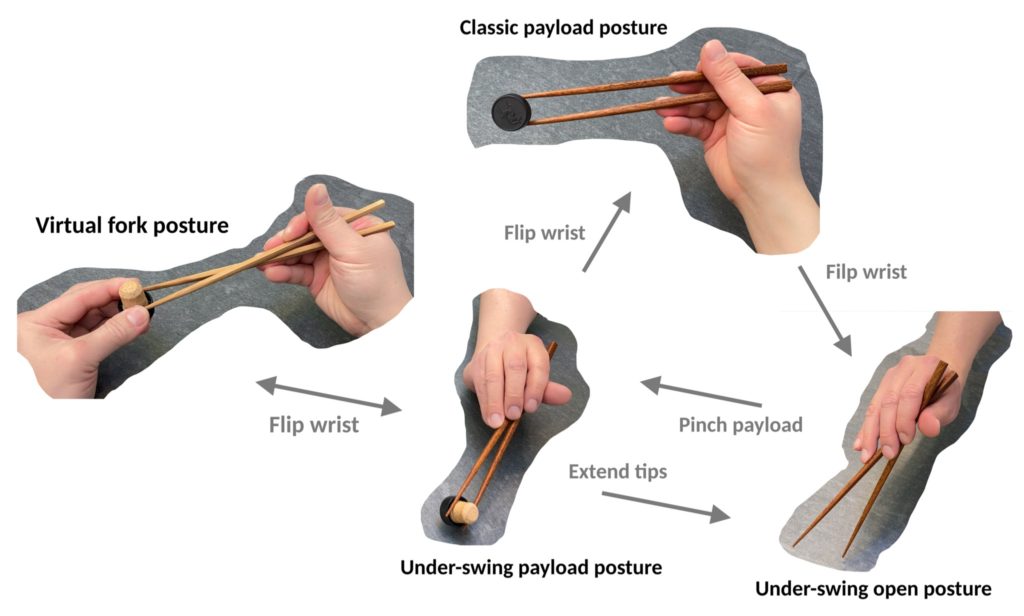
Last words
As usual, chopstick users do not always stick to one single grip. We have observed users of other alternative grips switching to Cupped Vulcan, for better purchase on food. One documented use case is described in the Dangling Stick article.
If Cupped Vulcan works well for you, that is great. If you would like to add more alternative grips into your chopsticking repertoire, then start with learning Standard Grip.
Update 2021-05: in popular culture
In May 2021 we analyzed an excellent episode on chopsticks and chopsticking by World Friends YouTube channel. We published a writeup of this review in YouTube episode on chopsticking from WorldFriends.
All three hostesses wield more than one chopstick grips. Two of three hostesses naturally use Lateral compression. The hostess Jane extends chopsticks apart with Idling Thumb, but closes them against food items with Lateral compression. Sometimes she adopts Cupped Vulcan for extending chopsticks apart. This is the first time we see Cupped Vulcan in popular culture. But we think we’ll find more.
Taiwanese: 拱手某牽
This grip is known as 拱手某牽 (Gióng-chhiú Bó͘-khàn) in Taiwanese. “Bó͘-khàn” is a transliteration of the English “Vulcan””.
